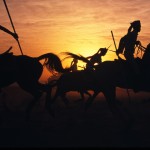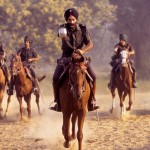South China Morning Post
29 June 2017
Iranian photographer Henry Dallal on how to make the queen smile for a photo, his lifelong passion for horses and keeping your cool when being charged by armed cavalry
BY TESSA CHAN
29 JUN 2017
I was born in Iran in 1955, and my love of horses and photography is due to my parents. My mother took me horse riding at the age of nine, and my father gave me a box Brownie then, too. It’s a wonderful old film camera, very basic. My father was always taking pictures, so I thought it was a normal thing to do.
After studying marketing at university in Colorado, in the United States, I returned to Iran to join my father’s import and export business. But then the 1979 revolution happened, so we ran away to England, where I sold my first photo in 1980. After two years, I moved back to Colorado. I returned to London in 1994 and have not left since.
One day, I got lucky: I saw the Household Cavalry (the queen’s official bodyguard) in Knightsbridge, and I was invited to ride one of the horses – every morning they invite a few civilians to ride. After that, I started taking pictures of the cavalry all the time until I became invisible to them. I had no idea I would end up making a book about them. It was fascinating for me to see the colours, the horses, the uniforms.
In 1999, I was invited to exhibit my work at Kensington Palace. I was involved in the property investment business and it suddenly occurred to me, why wait to retire to go and photograph a remote tribe somewhere? The tribe I’m looking for is right here, next door to me in London.
“The art of portrait photography is to be able to take a single picture that tells the story of the life of that person. You have to forget about how famous or powerful a person is. You become just two people talking, and you take a picture”
For my 2003 book, Pageantry & Performance, I wanted to record everything the Household Cavalry does. I spent six years embedded with them. The public never sees how hard they work behind the scenes, they only see a parade once a year. There’s a history, a tradition that goes back 350 years.
The commander of the cavalry – the boss – is Her Majesty the Queen. It’s very symbolic. But her personal passion is horse racing. She owns racehorses and she rides her horses all the time, still. She knew that I like horses, too, so I was invited to meet her in 2001, and to do her portrait for her golden jubilee (in 2002).
I’ve been very honoured since: my latest portrait of her is the official portrait for her 90th birthday in 2016. I found a sea of daisies for the foreground, and we had Her Majesty with her horses. You need to get the horses ears right, so I had somebody behind me doing jumping jacks, making fun of me. The queen laughed because she found that funny, but it was really to make their ears stand up.
Desert Pageantry: The Royal Cavalry of Oman was all shot on film. That book took me about eight years. I printed it in 2013.
They have 1,200 horses. It took me a long time to get the Galloping Greys picture, which I shot in Seeb, Oman, in 2011. I’m still not happy with it. I had this vision of horses galloping wild, but to create it was difficult. It’s only at the moment of release that you get this explosion of action but it had to be safe for the horses.
I went to the top general, and he said, “No, you’re not allowed to do that. It’s impossible.” So I went to the sergeant in charge of the stables. He said, “Sure, no problem.” We took 20 horses about 4km out, and we did it. The problem was that the light was not right. So the next morning, I go again – and this time the general comes to watch. We take 30 horses 5km out. They release the horses, and I’m there, waiting for them to run this way, but they don’t. They wait, and then they start running the other way – to town. I’ve got the general there with me, and I’m thinking, “Oh my God, these 30 royal, purebred Arab horses are going to run wild into town. They are all going to die.” Fortunately the tide was up so they couldn’t go much further.
That wasn’t my most challenging shoot. In 2006, I was asked to do some official portraits of the queen and Princess Anne and some top generals for the museum of the Household Cavalry. Put me in front of 100 horses galloping towards me – no problem. But this was inside, I had to use lighting, it was staged and each subject had to have a painting behind them. I wondered, “How do I make it interesting?” I had to go into Buckingham Palace, find a room, choose the right painting – for the queen it was her great, great grandfather, King George III – and bring the right lighting. You have to think about these things, you have to plan.
To me, the art of portrait photography is to be able to take a single picture that tells the story of the life of that person. You have to forget about how famous or powerful a person is. You become just two people talking, and you take a picture.
In 2007, I was invited to photograph and create a book on the 61st Cavalry in Rajasthan, India. The Indian cavalry have a charge, and they bring out their swords, and they gallop like they used to do in days of old. I thought it’d be nice to capture that. That was pretty stupid, actually. A horse, as long as you don’t move, will not run right into you, it will go around you. I realised, though, that one of the horses could push another one to the side a little bit, and I’d be a target – a simple miscalculation. I did one try, and that was it.
I don’t want to be a slave to the camera; I want the camera to be a slave to me. I like to have experiences, and then take pictures of those experiences. I try to take the minimal amount of equipment possible. Most of my cameras have to tolerate riding on the back of a horse, being thrown on the floor of a jeep, going over rough roads or being in the sand.
Not every picture’s perfect; sometimes I make a mistake, but sometimes the mistake looks perfect, because it’s creative. You have to know your subject, to anticipate what’s going to happen. Each discipline has its perfect moment, the height of the action. But there’s one more element, and that’s luck. Every time I’ve received a “no”, seemingly reached a dead end, somehow I’ve ended up in a better position, in a better location, at a better moment.
Henry Dallal was in town to give a talk titled “The Nobility of Equine Pageantry”, organised by the Royal Geographical Society at the Hong Kong Club, 1 Jackson Road, Central.



